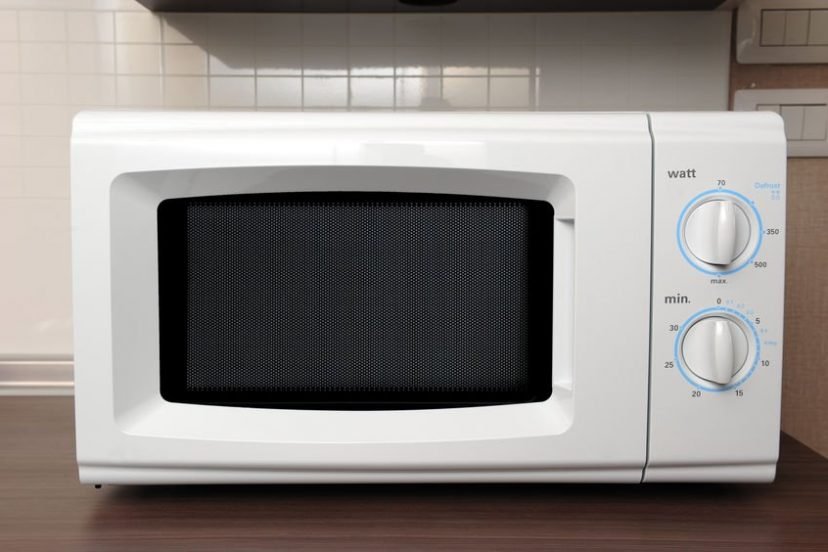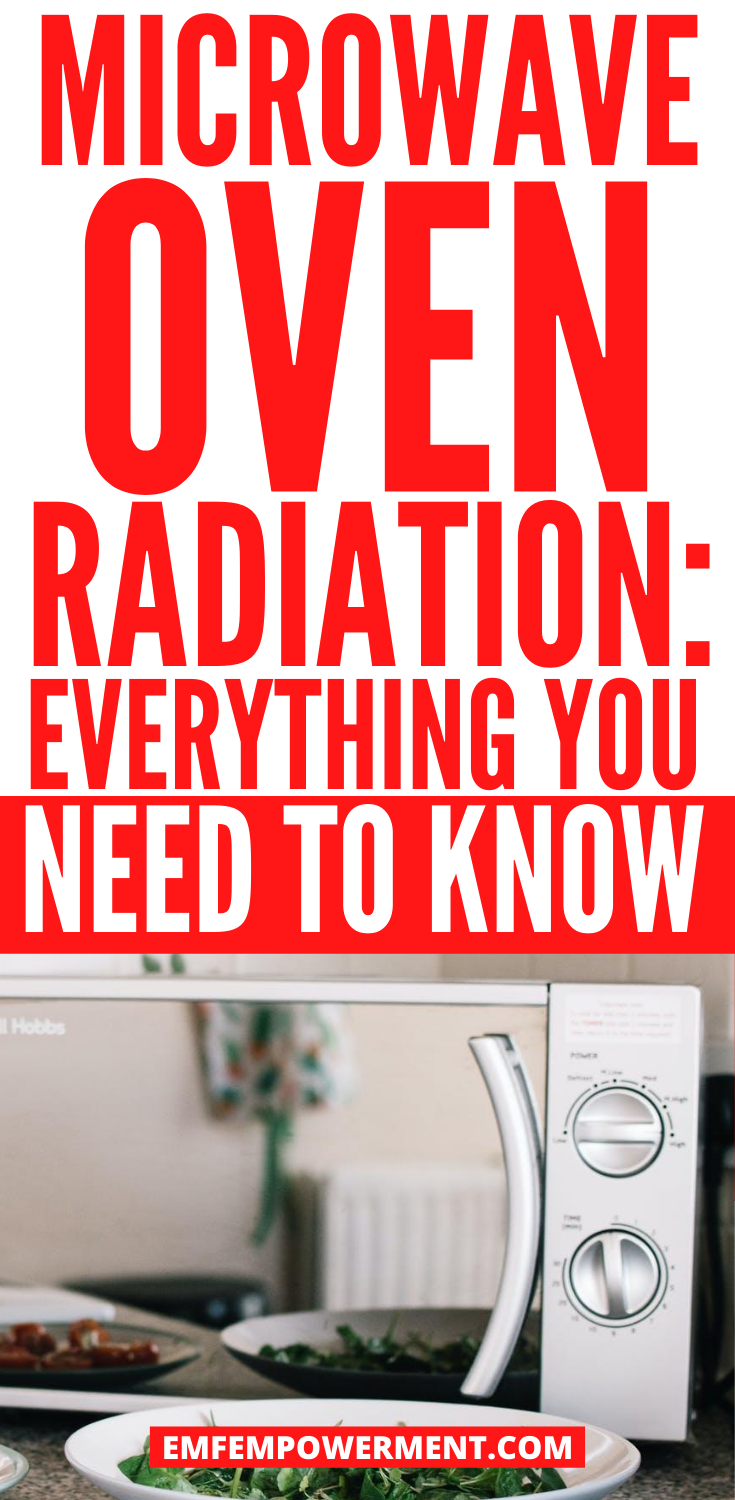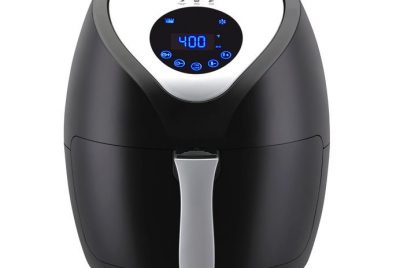On April 3, 1973, the first mobile phone was created. Since then, cell phone technology has…
Microwave Oven Radiation: Everything You Need to Know

*We may earn a commission for purchases made using our links. Please see our disclosure to learn more.
What appliances are in your kitchen? Odds are you have a stove and oven, refrigerator, maybe a dishwasher, possibly a trash compactor, and, almost definitely, a microwave oven.
Microwaves are in nearly every modern home. They offer convenience and speed — something that many families truly can’t imagine life without. It’s easy to pop some leftovers or a pack of popcorn into the microwave, set the timer, and let it go. These appliances rival a conventional oven with their usefulness.
But all of these benefits come at a price, and it could be your health. Microwave ovens produce radiation, and it could be in high enough quantities to cause lasting cellular damage and major health problems. Certain forms of cancer, male infertility, and other health issues are associated with the type of radiation produced by microwave ovens.
Microwaves can be scary, but there are things you can do to protect yourself. We’re going to cover how exactly microwaves are dangerous, and what you can to do lower your risk.
How do microwaves produce radiation?
Before answering this question, it may be helpful for you to understand how microwave ovens actually work. Microwaves operate using something called a magnetron. A magnetron is essentially a vacuum that creates waves in the microwave frequency. Specifically, modern microwaves operate at 2.45GHz.
When food is exposed to microwave waves, it begins the process of dielectric heating. What this means is that molecules inside of the food begin to heat up. As this continues, the food is able to cook much more quickly than it would in a conventional oven.
So where does radiation come in? The waves produced by a microwave are actually a form of electromagnetic radiation. In addition to the RF-EMF radiation produced to heat the food, microwaves also have a tendency to generate a substantial amount of dirty electricity — and, therefore, ELF-EMF radiation.
Microwaves and EMF
In theory, the radiation produced by your microwave is entirely contained by the unit. Microwaves come with plates on the sides and seals on the door that are designed to reduce the amount of EMF radiation the user is exposed to.
However, microwaves produce a great deal of EMF radiation in spite of these safety measures. Generally, microwave ovens are designed to prevent physical burns and other injuries from radiation exposure. This is because of government regulations, which we’ll get into shortly. The amount of radiation produced by a microwave may not cause a burn, but it may still cause cellular damage.
Existing studies on the topic are lacking. One by the Beijing Institute of Research Medicine concluded that further studies are necessary because the methodology of current studies may be questionable. At the very least, this is a topic that warrants further research because of the widespread use of microwave ovens and their close proximity to our food.
Government regulations
There are government regulations regarding microwave oven radiation. In the United States, microwaves may not produce more than 5mW of radiation per square centimeter at a distance of two inches. These regulations do not necessarily take into consideration any cellular damage that may occur from microwave oven exposure. They are primarily intended to reduce physical injuries.
The International Association for Research on Cancer, an off-shoot of the World Health Organization, acknowledges the potentially cancer-causing abilities of the type of radiation produced by microwave ovens. The IARC classifies RF-EMF radiation as “possibly carcinogenic.” This is based on a study that suggests radio frequencies may cause heart and brain tumors in rats. This study pertained primarily to cellular radiation, but microwaves may well have the same effect. They simply haven’t been studied enough to say for sure.
Testing your microwave
After learning about the dangers of microwave oven radiation, you may be wondering how much EMF your home microwave actually emits. If you have an EMF meter, you can easily check this. If not, look into purchasing one that can detect all three forms of EMF radiation. The TriField TF2 is an excellent, albeit expensive, option. For those looking for an EMF meter that is known for its accuracy and reliability, however, it’s well worth the price.
Once you’ve decided on an EMF meter, the next step is to take some measurements at varying distances away from the microwave. Take two readings each time — one with the microwave off, for a baseline for comparison, and one with the microwave running. You’ll want to take a reading directly next to the microwave, as well as at three to five feet away, and again at ten feet away. If your reading is still high, continue this process until you find where the radiation starts to drop off. This will give you some idea of the safest place to stand while the microwave is running.
If your microwave is on a shared wall with another room, repeat this process on the other side of the wall. You will need to be mindful of this when it comes to positioning furniture in the room. Don’t place a bed or couch, for example, along a shared wall with a microwave. If at all possible, avoid putting your microwave along a shared wall with a high traffic area of your home.
While testing your microwave oven with an EMF meter is the most accurate way to determine how much radiation your microwave is producing, EMF meters can be costly. Since microwaves are designed to contain most of the radiation produced by the unit, you may be safe just standing ten or so feet away when it’s in use. There is always the possibility, however, that the seal on your door has a leak, and radiation from the microwave is escaping from the chamber.
To see if this is the case, you can try the phone trick. You’ll need two phones for this, and at least one of them should be a cell phone. Put the cell phone in the microwave and call it with the second phone. If it rings, that means a signal is able to pass through the microwave door. If it doesn’t, your microwave seal is solid. This works because microwave radiation and cell phone radiation are both forms of RF-EMF radiation, and while they operate at slightly different frequencies, they are relatively close on the spectrum.
Are there low EMF microwaves?
You may now be wondering — do they make any microwaves that are low EMF? Unfortunately, however, there really aren’t any low EMF microwaves on the market. Radiation is a central part of how microwave ovens work, as we went over earlier. For that reason, it would be difficult, if not impossible, to create a low EMF microwave. It would have to operate on an entirely different principle than a traditional microwave.
While there may not be low EMF microwaves, some do produce more radiation than others. This is due to the microwave’s seal. In general, the tighter the seal, the less EMF the microwave should produce as more radiation is contained in the microwave’s cavity.
Keeping yourself safe
Your absolute best bet is to get rid of your microwave. In today’s fast-paced world, however, this is not always an option. Many people can’t imagine life without a microwave. If you’re one of them, there are a few things you can do to lower your exposure. Nothing will eliminate EMF radiation entirely, but there are steps you can take to reduce your risk of suffering from EMF-related illness.
1. Maintain your distance
One thing you should always do when it comes to using a microwave is to keep your distance while the device is in use. EMF radiation levels increase exponentially the closer you get to the microwave oven, and this is something to be mindful of. The levels of radiation you’re exposed to when standing next to the unit are significantly higher than when you are standing a few feet away. You can cut down on your exposure simply by maintaining a distance from the microwave while it is running.
2. Purchase a microwave shield
Microwave shields are an option for those who need to use a microwave oven. One such product is the Microwave Radiation Protection Cover. It is made from 30% metal fiber and is advertised as reducing 99% of the radiation produced by a microwave. In order to use this shield, however, your microwave must match the size of the shield.
A better bet may be to fashion your own microwave shield out of a high-quality protective fabric made from a blend that includes nickel, copper, silver, or another EMF-absorbing material. One example is Faraday Fabric, which is highly effective at attenuating microwave frequencies. If creating your own shield, the goal isn’t necessarily to cover the entire microwave in fabric. Instead, if your microwave is located in an enclosure, consider covering the enclosure walls in fabric, or even painting them with EMF repellant paint.
3. Cook with alternatives when possible
Even if you have to have a microwave in the home, you don’t need to cook with it all the time. Consider heating food up on the stovetop, in a conventional oven, or in a toaster oven. As an added bonus, most of the time this will taste better, anyway. Take french fries, for example. When you heat them up in the microwave, they tend to get soggy. Taking the time to reheat them in a conventional oven results in less EMF exposure, and crispier french fries.
4. Eat fewer processed, microwaved foods
One thing you can do that will provide a whole slew of benefits is to switch up your diet. Include fewer foods that need to be microwaved, and instead focus on fresh produce and foods that are cooked using whole, clean ingredients. Stay away from TV dinners, canned soup, and other foods that are more for convenience than health. These tend to be high in sodium and empty calories, and they encourage frequent use of a microwave oven. This step is tough, but your body will thank you for a number of reasons.
5. Update your microwave
Older microwave ovens don’t necessarily produce more EMF radiation. The problem is, the seals on the door that are designed to keep the radiation contained break down over time. When that happens, radiation is able to leak out. The seals can break down simply from standard wear and tear, and they may even look fine. The best way to tell if yours is leaking is the cell phone trick mentioned earlier. If a signal is passing through the door, it might be time to upgrade to a newer model of microwave.
6. Install a dirty electricity filter
As mentioned earlier, microwaves tend to generate dirty electricity. This happens when more electricity is provided to the microwave than is consumed. As these appliances become more energy-efficient, they will produce more dirty electricity. One way to cut down on this is to install a dirty electricity filter on the same circuit as the microwave. These filters are relatively inexpensive and designed to absorb and eliminate dirty electricity on an entire circuit.
Final thoughts
Microwave ovens and EMF radiation go hand in hand. You literally can’t have one without the other. For that reason, ditch the microwave if at all possible. If you’re trying to lower your family’s EMF exposure, this is one way to do just that.
If life without a microwave just isn’t for you, at least take steps to protect yourself. Until more research has been done into the safety of microwave ovens, take common-sense steps to protect yourself. Install a dirty electricity filter to protect against ELF-EMF radiation. Don’t stand too close to the microwave, and don’t use it more often than absolutely necessary. Use a toaster oven as an alternative when possible, and try to avoid placing the microwave in or near a high-traffic area. And when all else fails, opt for healthy, unprocessed foods that don’t require any microwaving. These steps won’t eliminate your exposure completely, but they will go a long way toward lowering your EMF levels — and when it comes to microwaves, that’s the best you can hope for. 



